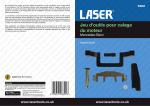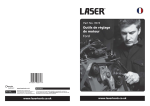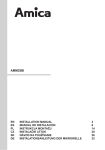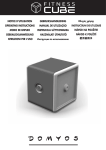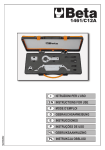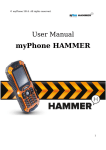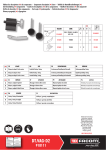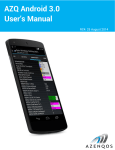Download Beta 1461/C17
Transcript
Beta 1461/C17 I ISTRUZIONI PER L’USO GB INSTRUCTIONS F MODE D’EMPLOI NL E PL GEBRUIKSAANWIJZING INSTRUCCIONES INSTRUKCJA OBSŁUGI Beta ISTRUZIONI PER L’USO I ART. 1461/C17 Kit di messa in fase per motori a benzina 3 cilindri gruppo VAG IMPORTANTE: si raccomanda di fare sempre riferimento al manuale d’officina della casa costruttrice per essere aggiornati sulle esatte procedure e dati ad essa collegati. Applicazioni: Motori 3 cilindri 1.2 monoalbero (6v.) e doppio albero a camme (12v.) SEAT Ibiza/Cordoba SKODA Fabia VOLKSWAGEN Polo Eos Fox Codice motori AWY, AZQ, BMD e BME Contenuto del kit Numero 1 2 3 Articolo D811 D812 D813 Descrizione Blocco camma (AWY/BMD) Coppia blocco camma (AZQ/BME) Blocco albero (AWY/AZQ/BMD/BME) D811 Blocco camma - AWY/BMD Controllo messa in fase Il blocco camma D811 si inserisce dalla parte superiore del motore per localizzare la sede ricavata sull’albero a camme, che serve per il giusto posizionamento dello sterzo. 1. Rimuovere il filtro dell’aria, il sensore Hall di fase e il sensore RPM. 2. Ruotare l’albero motore, nel suo normale senso, così che la sede del D811 sia visibile attraverso il foro del sensore Hall. 3. Inserire il blocco camma D811, che dovrebbe inserirsi agevolmente. 4. Assicurare il blocco camma con un bullone M6. D813 Blocco albero - AWY/BMD/AZQ/BME Il D813 viene utilizzato sia sul motore con doppio albero a camma in testa sia sul monoalbero. L’albero motore viene bloccato nella giusta posizione inserendo il blocco D813 attraverso il foro presente nel motore nella sede presente nel volano. Se, una volta inserito il D811, non fosse possibile inserire il D813, rimuovere il D811, far compiere un giro al motore, e reinserire il D811 e il D813. Messa in fase Se non fosse possibile inserire sia il D811 o il D812 agevolmente, il motore potrebbe essere fuori fase. Per fasare il motore, seguire la seguente procedura: 1. Posizionare il D811 seguendo la procedura descritta in “Controllo messa in fase” 2. Utilizzare un attrezzo per bloccare la ruota dentate dell’albero a camme e allentarne il bullone. 3. Ruotare l’albero motore fino a che non sia possibile inserire agevolmente il D813 nel volano. 4. Serrare il dado di fissaggio della ruota dentate 5. Rimuovere tutti I blocchi e far compiere all’albero motore due rivoluzioni 6. Ripetere la procedura “Controllo messa in fase” D812 Coppia blocco camma - AZQ/BME La procedura per bloccare il motore con doppio albero a camme in testa è simile a quella descritta sopra per il monoalbero; l’unica differenza è che deve essere inserita una coppia di blocchi, i D812. Per fasare il motore, seguire la seguente procedura: 1. Rimuovere il filtro dell’aria, il sensore Hall di fase, il sensore RPM e i coperchi posteriori degli alberi a camme 2. Ruotare l’albero motore fino a che le sedi ricavate nel retro degli alberi a camme siano orizzontali. 3. Inserire i D812 nelle apposite sedi e assicurarli con un bullone M6. 4. Bloccare l’albero motore inserendo il D813. Per fasare il motore: 1. Inserire i D812 e allentare i dadi di ritegno delle ruote dentate avendole preventivamente bloccate con un attrezzo idoneo. 2. Ruotare l’albero motore fino a che non sia possibile inserire agevolmente il D813 nel volano. 3. Serrare il dado di fissaggio della ruota dentate 4. Rimuovere tutti I blocchi e far compiere all’albero motore due rivoluzioni 5. Ripetere la procedura “Controllo messa in fase”. Beta INSTRUCTIONS GB ART. 1461/C17 Petrol Engine Setting/Locking Tool Kit IMPORTANT: Always refer to the vehicle manufacturer’s service instructions, or proprietary manual, to establish the current procedures and data. Product Information Sets detail applications and use of the tools with any general instructions provided as a guide only. Applications: V W GROUP 1.2 Single (6v.) and Twin Camshaft (12v.) 3 cylinder Petrol engines (02-) in SEAT Ibiza/Cordoba SKODA Fabia VOLKSWAGEN Polo Eos Fox AWY, AZQ, BMD and BME engines Kit contents Item 1 Part Number D811 2 D812 3 D813 Description Camshaft Setting Tool (AWY/BMD) Camshaft Setting Tool Set -PAIR (AZQ/BME) Flywheel Locking Pin (AWY/AZQ/BMD/BME) The V W Group 1.2 petrol engine range, introduced from 2001, can be single camshaft 6 valve engine variants (Codes AWY/BMD) or twin camshaft 12 valve engines (Codes AZQ/BME). Chain drive - crankshaft to camshaft(s), they require use of a Flywheel Locking Pin, common to all these engines, and a Camshaft Setting Tool for single overhead camshaft.-AWY/BMD, and a pair of Camshaft Setting Tools for the twin camshaft-AZQ/BME engines. The crankshaft is locked in timed position by inserting D813 Pin through the engine housing and into the flywheel. If, with D811 Camshaft Tool in position, it is not possible to insert the D813 Pin, remove D811 Camshaft Tool, turn the engine 360°, and then insert Camshaft Tool and Flywheel Pin. Valve Timing Adjustment If it is not be possible to insert both the Camshaft Tool and Flywheel Pin with ease, the engine timing can be adjusted. First, positioning the ‘timing slot’ in the camshaft so it is visible in the hole used for the Hall sender unit and insert D811 Tool. Next, using a suitable sprocket counter-holding tool, counter-hold the camshaft sprocket and slacken its bolt. Then, turn the crankshaft until D813 Pin can be inserted correctly into the flywheel. Finally, counter-hold the camshaft sprocket and tighten the sprocket bolt. Remove both tools, rotate the crankshaft 2 times, and recheck valve timing by ensuring D811 and D813 can be fitted correctly and with ease. D811 Camshaft Setting Tool - AWY/BMD Checking valve timing D811 Camshaft Setting Tool enters through the top of the engine to locate the ‘timing slot’ in the camshaft. Remove the air cleaner, Hall sender unit and engine speed sensor. Turn the crankshaft, in the normal direction of engine rotation, so that the ‘timing slot’ in the camshaft is visible in the hole used for the Hall sender unit. Insert D811 Camshaft Setting Tool. It should locate into the camshaft ‘timing slot’ with ease. Secure the tool in place with a M6 bolt. D813 Flywheel/Crankshaft Locking Pin (D813 is used for both twin camshaft and single camshaft engines (Codes AWY/BMD/AZQ/BME) D812 Camshaft Setting Tools (Pair) - AZQ/BME Engine setting and locking on the twin camshaft engines is a similar procedure to that used on the single camshaft engines, except the pair of Camshaft Setting Tools - D812, enter ‘timing slots’ in the rear of the camshafts. Remove the air cleaner and both camshaft end covers located at the rear of the camshafts. Remove the engine speed sensor and rotate the crankshaft so that the ‘timing slots’ in the rear of camshafts are horizontal. D812 Camshaft Setting Tools can now be inserted into the ‘timing slots’ and secured in place with M6 bolts, hand tight only. The crankshaft is locked in timed position by inserting D813 Pin through the engine housing and into the flywheel, the same position as used for single camshaft engines. For valve timing adjustment on twin camshaft engines, fit both of the D812 Camshaft Setting Tools and slacken both camshaft sprocket bolts. Insert D813 Flywheel Locking Pin and counterhold camshaft sprockets whilst tightening the sprocket bolts. Follow the same procedure as detailed in “Valve Timing Adjustment” section above. Beta MODE D’EMPLOI F ART. 1461/C17 Kit de calage pour moteurs essence 3 cylindres groupe VAG IMPORTANT : il est vivement recommandé de se référer toujours au manuel d’atelier du fabricant afin de connaître les procédures actualisées à suivre et les données corrélées. Applications : Moteurs 3 cylindres 1.2 monoarbre (6 soupapes) et double arbre à cames (12 soupapes) SEAT Ibiza/Cordoba SKODA Fabia VOLKSWAGEN Polo Eos Fox Référence moteurs AWY, AZQ, BMD et BME Contenu du kit N° 1 2 3 article D811 D812 D813 description Bloc came (AWY/BMD) Couple bloc came (AZQ/BME) Bloc arbre (AWY/AZQ/BMD/BME) Calage S’il n’est pas possible d’insérer le D811 ou le D812 sans difficulté, il se peut que le moteur soit décalé. Pour recaler le moteur, procéder de la façon suivante : 1. Positionner le D811 en suivant la procédure décrite dans “Contrôle calage” ; 2. Utiliser un outil pour bloquer la roue dentée de l’arbre à cames puis desserrer le boulon ; 3. Tourner l’arbre moteur jusqu’à ce qu’il soit possible d’introduire aisément le D813 dans le volant ; 4. Serrer l’écrou de fixation de la roue dentée ; 5. Enlever tous les blocs et faire accomplir deux révolutions à l’arbre moteur ; 6. Répéter la procédure “Contrôle calage” D811 Bloc came - AWY/BMD Contrôle calage Le bloc came D811 s’insère par la partie supérieure du moteur pour localiser l’emplacement prévu sur l’arbre à cames, qui sert à bien positionner la direction. 1. Enlever le filtre à air, le capteur Hall de phase et le capteur RPM. 2. Tourner l’arbre moteur, dans le sens de rotation normal, de façon à ce que l’emplacement du D811 soit visible à travers le trou du capteur Hall. 3. Insérer le bloc came D811, qui devrait entrer sans difficulté. 4. Assujettir le bloc came à l’aide d’un boulon M6. D813 Bloc arbre - AWY/BMD/AZQ/BME Le D813 est utilisé aussi bien sur le moteur à double arbre à came en tête que sur le monoarbre. L’arbre moteur est bloqué dans la bonne position en introduisant le bloc D813 à travers le trou présent sur le moteur dans l’emplacement se trouvant dans le volant. Si après avoir inséré le D811, il n’est pas possible d’insérer le D813, alors enlever le D811, faire accomplir une rotation complète au moteur puis réinstaller le D811 et ensuite le D813. D812 Couple bloc came - AZQ/BME La procédure pour bloquer un moteur équipé d’un double arbre à cames en tête est semblable à celle décrite pour le monoarbre ; la seule différence est qu’il faut insérer une paire de blocs, les D812. Pour caler le moteur, suivre la procédure suivante : 1. Enlever le filtre à air, le capteur Hall de phase, le capteur RPM et les couvercles arrière des arbres à cames ; 2. Tourner l’arbre moteur jusqu’à ce que les emplacements présents à l’arrière des cames soient horizontaux ; 3. Insérer les D812 dans les emplacements prévus à cet effet et les assujettir à l’aide d’un boulon M6 ; 4. Bloquer l’arbre moteur en insérant le D813. Pour caler le moteur : 1. Insérer les D812 et desserrer les écrous de retenue des roues dentées après les avoir préalablement bloquées à l’aide d’un outil approprié ; 2. Tourner l’arbre moteur jusqu’à ce qu’il soit possible d’introduire aisément le D813 dans le volant ; 3. Serrer l’écrou de fixation de la roue dentée ; 4. Enlever tous les blocs et faire accomplir deux révolutions à l’arbre moteur ; 5. Répéter la procédure “Contrôle calage”. Beta GEBRUIKSAANWIJZING NL ART. 1461/C17 Kit om 3-cilinder benzinemotoren van de VAG-groep af te stellen BELANGRIJK: voor de juiste procedures en gegevens wordt aanbevolen altijd de handleiding van de fabrikant voor de werkplaats te raadplegen. Toepassingen: 3-cilindermotoren 1.2 monoalbero (6v.) en dubbele nokkenas (12v.) SEAT Ibiza/Cordoba SKODA Fabia VOLKSWAGEN Polo Eos Fox Motorcodes AWY, AZQ, BMD en BME Inhoud van de kit Nummer 1 artikel D811 2 D812 3 D813 beschrijving Nokkenasblokkeergereedschap (AWY/BMD) Stel nokkenasblokkeergereedschappen (AZQ/BME) Asblokkering (AWY/AZQ/BMD/BME) Het afstellen Als het niet mogelijk mocht zijn de D811 of de D812 gemakkelijk aan te brengen, kan het zijn dat de motor slecht afgesteld is. Om de motor af te stellen, volgt u de volgende procedure: 1. Plaats de D811 volgens de procedure die beschreven wordt in “De afstelling controleren” 2. Gebruik gereedschap om het tandwiel van de nokkenas te blokkeren en de bout ervan los te draaien. 3. Draai de motoras tot de D813 gemakkelijk in het vliegwiel kan worden gedaan. 4. Draai de bevestigingsmoer van het tandwiel aan 5. Verwijder alle blokkeringen en laat de motoras twee omwentelingen maken 6. Herhaal de procedure “De afstelling controleren” D811 Nokkenasblokkeergereedschap - AWY/BMD De afstelling controleren Het nokkenasblokkeergereedschap D811 moet aan de bovenkant van de motor worden aangebracht om de plaats te bepalen op de nokkenas, die nodig is voor de juiste plaatsing van het stuur. 1. Verwijder het luchtfilter, de Hall fase sensor en de RPM sensor. 2. Draai de motoras in de normale draairichting, zodat de plaats van de D811 door de opening in de Hall sensor zichtbaar is 3. Breng het nokkenasblokkeergereedschap D811 aan, wat gemakkelijk moet kunnen. 4. Zet het nokkenasblokkeergereedschap met een M6 bout vast. D813 Asblokkering - AWY/AZQ/BMD/BME De D813 wordt zowel op een motor met dubbele nokkenas op de kop gebruikt, als op een monoalbero. De motoras wordt op de juiste plaats geblokkeerd door de blokkering D813 door de opening in de motor op de plaats in het vliegwiel aan te brengen. Als het niet mogelijk mocht zijn de D813 aan te brengen als de D811 eenmaal is aangebracht, draait u de motor een slag en brengt u de D811 en D813 opnieuw aan. D812 Stel nokkenasblokkeergereedschappen AZQ/BME De procedure om de motor met dubbele nokkenas op de kop te blokkeren, lijkt op de bovenbeschreven procedure voor de monoalbero. Het enige verschil is dat een stel blokeergereedschappen, de D812, aangebracht moeten worden. Om de motor af te stellen, volgt u de volgende procedure: 1. Verwijder het luchtfilter, de Hall fase sensor, de RPM sensor en de achterste deksels van de nokkenassen 2. Draai de motoras tot de plaatsen aan de achterkant van de nokkenassen horizontaal staan 3. Breng de twee gereedschappen D812 op de speciaal hiervoor bestemde plaatsen aan en zet ze met een M6 bout vast. 4. Blokkeer de motoras door de D813 aan te brengen. Om de motor af te stellen: 1. Breng de twee gereedschappen D812 aan en draai de borgmoeren van de tandwielen los, die u voorheen met geschikt gereedschap heeft geblokkeerd. 2. Draai de motoras tot de D813 gemakkelijk in het vliegwiel kan worden gedaan. 3. Draai de bevestigingsmoer van het tandwiel aan 4. Verwijder alle blokkeringen en laat de motoras twee omwentelingen maken 5. Herhaal de procedure “De afstelling controleren”. Beta INSTRUCCIONES E ART. 1461/C17 Kit de puesta en fase para motores de gasolina de 3 cilindros grupo VAG IMPORTANTE: recomendamos que se remita siempre al manual de taller del fabricante para que esté siempre al día de los procedimientos exactos y de los datos relacionados con el mismo. Aplicaciones: Motores de 3 cilindros 1.2 monoarbol (6v.) y árbol de levas doble (12v.) SEAT Ibiza/Cordoba SKODA Fabia VOLKSWAGEN Polo Eos Fox Código de motores AWY, AZQ, BMD y BME Contenido del kit Número 1 2 3 artículo D811 D812 D813 descripción Bloqueo leva (AWY/BMD) Par de bloqueos leva (AZQ/BME) Bloqueo árbol (AWY/AZQ/BMD/BME) D811 Bloqueo leva - AWY/BMD Control de puesta en fase El bloqueo leva D811 se introduce por la parte superior del motor para localizar el alojamiento realizado en el árbol de levas, que sirve para el posicionamiento correcto de la dirección. 1. Retire el filtro de aire, el sensor Hall de fase y el sensor RPM. 2. Gire el árbol motor, en su sentido normal, de manera que pueda ver el alojamiento del D811 a través del orificio del sensor Hall. 3. Introduzca el bloqueo leva D811, que debería introducirse con facilidad. 4. Fije el bloqueo leva con un perno M6. D813 Bloqueo árbol - AWY/BMD/AZQ/BME El D813 se utiliza tanto en el motor con árbol de levas doble en culata como en el monoarbol. El árbol motor se bloquea en la posición correcta introduciendo el bloqueo D813 a través del orificio presente en el motor en el alojamiento presente en el volante. Una vez introducido el D811, de no ser posible introducir el D813, retire el D811, hágale hacer una revolución al motor, vuelva a introducir el D811 y el D813. Puesta en fase De no ser posible introducir el D811 o el D812 con facilidad, el motor podría estar fuera de fase. Para poner en fase el motor, proceda como sigue: 1. Coloque el D811 siguiendo el procedimiento que se detalla en “Control de puesta en fase”. 2. Utilice una herramienta para bloquear la rueda dentada del árbol de levas y afloje el perno. 3. Gire el árbol motor hasta cuando es posible introducir con facilidad el D813 en el volante. 4. Apriete la tuerca de fijación de la rueda dentada. 5. Retire todos los bloqueos y hágale hacer al árbol motor dos revoluciones. 6. Repita el procedimiento “Control de puesta en fase”. D812 Par de bloqueos leva - AZQ/BME El procedimiento para bloquear el motor con árbol de levas doble en culata es parecido al que se ha detallado para el monoarbol; la única diferencia es que han de introducirse dos bloqueos, los D812. Para poner en fase el motor, proceda como sigue: 1. Retire el filtro de aire, el sensor Hall de fase, el sensor RPM y las tapaderas traseras de los árboles de levas. 2. Gire el árbol motor hasta cuando los alojamientos realizados en la parte trasera de los árboles de levas estén horizontales. 3. Introduzca los D812 en los alojamientos destinados al efecto y fíjelos con un perno M6. 4. Bloquee el árbol motor introduciendo el D813. Para poner en fase el motor: 1. Introduzca los D812 y afloje las tuercas de retención de las ruedas dentadas después de bloquearlas previamente con una herramienta adecuada. 2. Gire el árbol motor hasta cuando es posible introducir con facilidad el D813 en el volante. 3. Apriete la tuerca de fijación en la rueda dentada. 4. Retire todos los bloqueos y hágale dar al árbol motor dos revoluciones 5. Repita el procedimiento “Control de puesta en fase”. Beta INSTRUKCJA OBSŁUGI PL ART. 1461/C17 Zestaw narzędzi do ustawiania układu rozrządu w silnikach benzynowych WAŻNE: Zawsze należy stosować się do instrukcji dostarczonych przez producenta pojazdu lub korzystać z odpowiedniego podręcznika, aby poznać aktualne dane i sposoby postępowania. Niniejsza instrukcja, dotycząca przeznaczenia i sposobu użytkowania zestawu narzędzi, ma jedynie charakter ogólny i informacyjny. Przeznaczenie zestawu narzędzi: Silniki benzynowe 1.2 grupy VW (02-), 3-cylindrowe z pojedynczym wałkiem rozrządu (6V) lub z dwoma wałkami rozrządu (12V) w samochodach: SEAT Ibiza/Cordoba SKODA Fabia VOLKSWAGEN Polo Eos Fox Kody silników: AWY, AZQ, BMD, BME Zawartość zestawu narzędzi: Poz. 1 2 3 Nr części Opis D811 Przyrząd do synchronizacji wałka rozrządu (AWY/BMD) D812 Komplet(para) przyrządów do synchronizacji wałków rozrządu (AZQ/BME) D813 Sworzeń do blokowania koła zamachowego (AWY/AZQ/BMD/BME) Silniki benzynowe 1.2 grupy VW, wprowadzone w roku 2001, dzielą się na 6-zaworowe silniki z pojedynczym wałkiem rozrządu (kody: AWY/BMD) oraz 12-zaworowe silniki z dwoma wałkami rozrządu (kody: AZQ/BME). Przy napędzie łańcuchowym (wał korbowy – wałek/wałki rozrządu) wymagane jest użycie sworznia do blokowania koła zamachowego, wspólnego dla obu typów silników, oraz przyrządu do ustawiania wałka rozrządu w silnikach z pojedynczym wałkiem rozrządu (AWY/BMD) lub pary przyrządów do ustawiania wałka rozrządu w silnikach z dwoma wałkami rozrządu (AZQ/BME) D811 Przyrząd do synchronizacji wałka rozrządu (AWY/BMD) Sprawdzenie synchronizacji zaworów Przyrząd do synchronizacji wałka rozrządu (D811) wprowadzamy przez otwór w górnej części silnika do rowka ustalającego na wałku rozrządu. Aby to wykonać, należy wpierw zdemontować filtr powietrza, czujnik Halla oraz czujnik prędkości obrotowej silnika.. Następnie należy obracać ręcznie wał korbowy zgodnie z normalnym kierunkiem obrotów silnika, aż rowek ustalający na wałku rozrządu ukaże się w otworze czujnika Halla.. Do tak ustawionego rowka ustalającego możemy wprowadzić przyrząd do synchronizacji wałka rozrządu (D811); powinien teraz wejść z łatwością..W tym położeniu przyrząd należy zamocować za pomocą śruby o rozmiarze M6. D813 Sworzeń do blokowania koła zamachowego (D813 jest przeznaczony do obu typów silników: z pojedynczym wałkiem i z dwoma wałkami rozrządu (kody: AWY/BMD/AZQ/BME) Po wprowadzeniu sworznia D813 do koła zamachowego przez otwór w obudowie silnika, wał korbowy zostanie zablokowany w położeniu zsynchronizowanym. Jeżeli nie można wprowadzić sworznia D813, a wcześniej zamontowano już przyrząd D811, należy wyjąć przyrząd D811, obrócić ręcznie wał korbowy o 360°, a następnie wprowadzić przyrząd D811 i sworzeń D813. Regulacja synchronizacji zaworów Jeżeli nie można z łatwością wprowadzić przyrządu D811 i sworznia D813, należy wyregulować rozrząd silnika. Najpierw należy ustawić wałek rozrządu w takim położeniu, aby rowek ustalający na wałku rozrządu ukazał się w otworze czujnika Halla i wtedy wprowadzić przyrząd D811. Następnie, przytrzymując specjalnym kluczem koło zębate wałka rozrządu, należy poluzować mocującą go śrubę.. Teraz możemy obracać ręcznie wał korbowy, aż sworzeń D813 wejdzie poprawnie w otwór koła zamachowego. Na końcu, przytrzymując specjalnym kluczem koło zębate wałka rozrządu, należy dokręcić mocującą go śrubę. Wyjąć przyrząd D811 i sworzeń D813, obrócić ręcznie wał korbowy 2 razy i ponownie sprawdzić synchronizację zaworów, poprzez upewnienie się, że D811 i D813 z łatwością mogą być umieszczone we właściwym położeniu. D812 Komplet(para) przyrządów do synchronizacji wałków rozrządu (AZQ/BME) Synchronizacja rozrządu w silnikach z dwoma wałkami rozrządu wykonywana jest w podobny sposób jak w silnikach z pojedynczym wałkiem rozrządu; różnica polega na użyciu pary przyrządów D812, które wprowadzamy do rowków ustalających, znajdujących się w tylnej części obu wałków rozrządu. Najpierw należy zdjąć filtr powietrza i obie pokrywy tylne wałków rozrządu. Następnie wyjąć czujnik prędkości obrotowej silnika i obracać ręcznie wał korbowy, aż rowki ustalające, zlokalizowane w tylnej części obu wałków rozrządu, ustawią się w poziomie. W tak ustawione rowki ustalające należy wprowadzić oba przyrządy D812 i zamocować je za pomocą śrub o rozmiarze M6, dokręcając je wyłącznie ręcznie. Wał korbowy zostanie zablokowany w położeniu zsynchronizowanym, po wprowadzeniu sworznia D813 do koła zamachowego przez otwór w obudowie silnika.. W celu regulacji synchronizacji zaworów w silnikach z dwoma wałkami rozrządu, dopasować oba przyrządy D812 i poluzować śruby mocujące koła zębate wałków rozrządu. Następnie wprowadzić sworzeń D813 i, przytrzymując koła zębate wałków rozrządu, dokręcić mocujące je śruby. Postępować wg wskazówek w punkcie „Regulacja synchronizacji zaworów”. Beta BETA UTENSILI spa Via Volta, 18 20050 SOVICO (MI) ITALY Tel. +39.039.2077.1 Fax +39.039.2010742
















